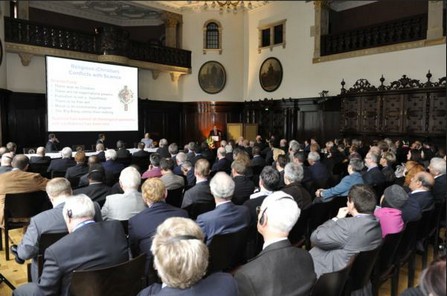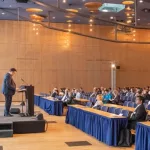From 21st – 24th March 2012, the Bremen Cotton Exchange and the Fibre Institute Bremen hosted the 31st International Cotton Conference in Bremen/Germany. More than 500 visitors from 42 countries visited the conference, which is traditionally held in the hanseatic city’s historic Town Hall. Not only the Conference theme – “Cotton and Synthetic Fibres – Competition or Compatibility” – was unusual this year. The weather, too, surprised many of the visitors to Bremen: for the whole week Bremen showed itself from its sunniest side, with very mild temperatures. The Conference was opened in bright sunshine in the Upper Town Hall with a witty speech from the President of the Bremen Chamber of Trade, Otto Lamotte. During the event, presentations highlighted different strategies for dealing with competitive pressures and opportunities for compatibility between natural and man-made fibres.
Speakers at the Bremen conference reported that biotechnology, high-speed roller ginning, advances against cotton diseases and improved conventional breeding techniques and other technological advances in agriculture are leading to increased productivity, reduced resource use and increases in carbon sequestration in natural fiber production.
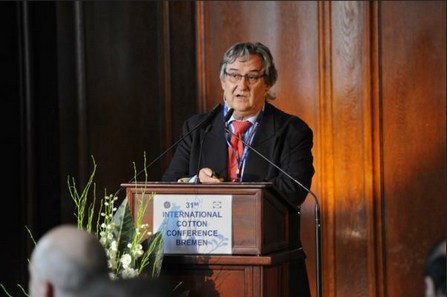
Keynote Speaker, Prof. Dr. Beda Stadler from Switzerland, spoke with an excellent scientific background and very humorously about the “schizophrenic relationship with genetic engineering”
Among the Conference highlights was certainly the Keynote Speaker, Prof. Dr. Beda Stadler from Switzerland, who spoke with an excellent scientific background and very humorously about the “schizophrenic relationship with genetic engineering”. Prof. Stadler is well known for being outspoken and willing to sometimes cross the line to reach the audience. In Bremen, too, he lived up to his reputation and the presentation was discussed intensively for a long time.
Jens Lukaczik, president of the Bremen Cotton Exchange, said: “The 31st ICC Bremen continued a tradition of industry excellence amidst an atmosphere of improvement, growth and optimism about both the competitive position of natural fibres in world fibre use and the compatibility of natural fibres with other fibres in meeting consumer needs.”
The intrinsic quality of cotton fiber is improving, and the systems used in fiber quality measurement are increasingly standardized around the world, leading to improvements in accountability to customers and better compatibility with modern textile processes. New developments in cotton processing technology in spinning mills are leading to faster, more efficient and lower cost textile production processes resulting in improved textile product with enhanced performance as expected in a value-added product.
Reflecting the prestige and nearly universal attendance of industry leaders at the Bremen cotton conferences, major segments of the world cotton industry held board meetings or work sessions during the conference week.
Never before so many working groups came to Bremen to discuss the issue of cotton. For one week the ancient locations of Town Hall and Cotton Exchange Building offered a wonderful background for board meetings as well as international committees.
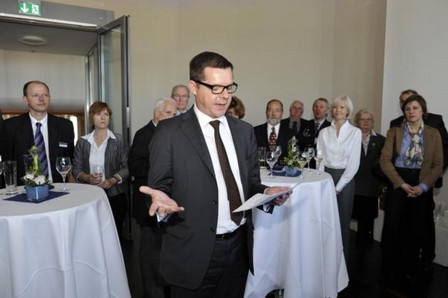 The 31st International Cotton Conference Bremen continued a tradition of industry excellence amidst an atmosphere of improvement,
The 31st International Cotton Conference Bremen continued a tradition of industry excellence amidst an atmosphere of improvement, 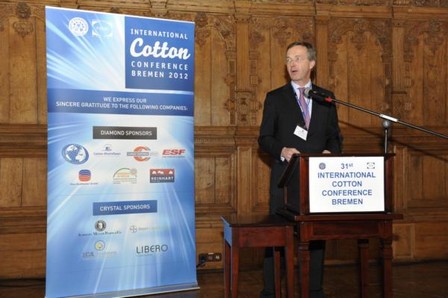 growth and optimism about both the competitive position of natural fibers in world fiber use and the compatibility of natural fibers with other fibers in meeting consumer
growth and optimism about both the competitive position of natural fibers in world fiber use and the compatibility of natural fibers with other fibers in meeting consumer 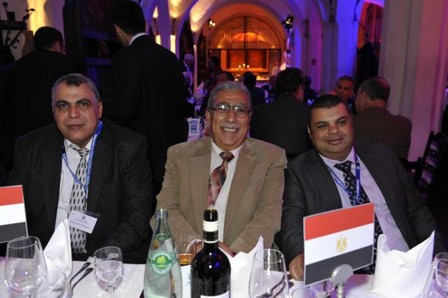 needs.
needs.
The Conference’s story began in the 1950’s as a cotton colloquium. However, over the course of time, this meeting of just a few scientists has developed into the International Cotton Conference Bremen and has become firmly established in the cotton world.
We are very happy about the continuously high participation, says Jens D.. Lukaczik, President of the Bremen Cotton Exchange. “Not one bale of cotton is grown in Bremen, the textile industry has mainly moved to Asia but we are able to bring more than 500 participants from 42 countries to Bremen/Germany. The Bremen conference has a historically grown importance for the international cotton industry. We maintain this by the high quality of our presentations.”
The 31st International Cotton Conference Bremen showcased both strategies for meeting competitive pressures and opportunities for compatibility between natural and man-made fibers in the 21st Century. Speakers at the Bremen conference reported that biotechnology, high-speed roller ginning, advances against cotton diseases and improved conventional breeding techniques and other technological advances in agriculture are leading to increased productivity, reduced resource use and increases in carbon sequestration in natural fiber production.
Study on climate change presented at 31st International Cotton Conference in Bremen
Use of crop protection products improves the carbon footprint
Cotton farmers who use crop protection products to safeguard their harvests are acting in a sustainable manner and contributing to climate protection. This is the verdict of a study called “Climate change and plant health” (“Klimawandel und Pflanzenge-sundheit”) conducted by the Berlin-based agency agripol on behalf of Bayer CropScience.
The findings were presented to the public at the 31st International Cotton Conference in Bremen, Germany. They supply facts about the impact of pesticide use on the carbon footprint (CO2 balance) using cotton-growing as an example.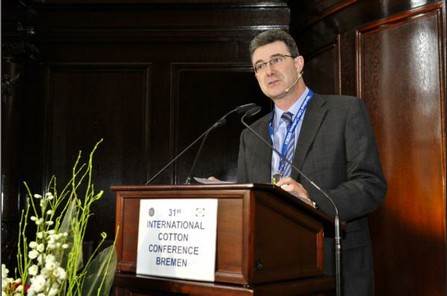 “We determined the energy consumption and all other CO2 emissions involved in the production and use of crop protection agents,” explained Dr. Rüdiger Schaub, Head of Sustainability at Bayer CropScience AG, at the presentation to the audience of international experts. On the other side of the equation were the increased biomass produced and the resulting additional carbon dioxide taken out of the earth’s atmosphere.
“We determined the energy consumption and all other CO2 emissions involved in the production and use of crop protection agents,” explained Dr. Rüdiger Schaub, Head of Sustainability at Bayer CropScience AG, at the presentation to the audience of international experts. On the other side of the equation were the increased biomass produced and the resulting additional carbon dioxide taken out of the earth’s atmosphere.
During the course of the study, 14 crops were examined in 16 countries. The analyzed data for cotton in the three most important growing countries show that the plant absorbs many times more carbon dioxide than is released by the use and production of the crop protection agents. In the investigated cases, the additional CO2 uptake outweighed the emissions by a factor of 25 to 50.
Irrigated farming in India: 20 times better carbon footprint
A sample calculation for irrigated farming in India makes the situation clear. The repeated use of pesticides made necessary by insect infestation leads to an additional consumption of 49.4 kilograms of carbon dioxide per hectare. Compared to untreated fields, however, approximately 1,900 kilograms more of the greenhouse gas is converted per hectare.
The footprint is even more positive if other influencing factors for the yield such as irrigation are taken into account in the calculation. “In the search for solutions to protect the climate and the importance of agriculture, well-founded information about the impact of agricultural inputs use is very important.
This study should provide new arguments to consider in the public debate,” said Schaub.
Cotton: king of natural fibers
Cotton is the world’s most important natural fiber and is currently grown on more than 30 million hectares of agricultural land in more than 80 countries. Measures to combat plant diseases and pests are essential to safeguard yields. Bayer CropScience is a global leader with products for cotton-growers and offers a wide range of seeds and traits along with products to control pests, diseases and weeds.
This extensive portfolio is rounded off by a full range of harvest-aid agents. Bayer’s renowned Fiber Max™, Stoneville™ and Surpass™ seed brands have been designed specifically to meet the needs of farmers, the fiber-processing industry and the end consumer.
Bayer CropScience is helping farmers worldwide meet the ever-increasing demand for affordable and high-quality food, feed, fiber and energy crops. The company offers high quality seeds and new solutions that enable farmers to increase their yields and protect their harvests. By continually discovering new approaches to deliver such solutions, the company is helping to shape the future of agriculture and create value for its customers and society.
Bayer CropScience is with annual sales of about EUR 6.8 billion one of the world’s leading innovative cropscience companies in the area of crop protection (Crop Protection), non agricultural pest-control (Environmental Science), seeds and plant biotechnology (BioScience).
